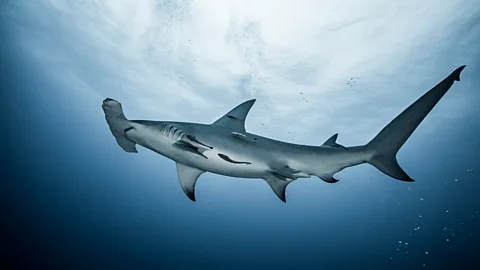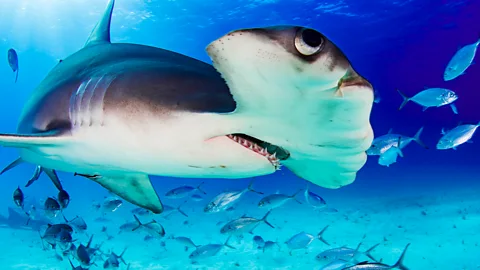A shark nursery may be a stone's throw from Miami's bright lights
 Getty Images
Getty ImagesGreat hammerheads are odd-looking and mysterious creatures, but scientists may have found the first ever nursery for these enormous sharks – in one of the busiest fishing spots in the world.
Few shark species can grab your attention like the great hammerhead.
As with all of the Sphyrnidae family, the great hammerhead sports a head that looks less like something a living creature would have and more like an spare part from a racing car prototype. Two eyes sit on either side of an aerodynamic spoiler (technically a "cephalofoil") above the mouth, like lifting surfaces on an aircraft.
After decades of research, we still don't quite know the evolutionary forces that led to the hammerhead's oddly shaped cranium. It's most likely because it helps the species better pick up the minute electric signals generated by their favourite prey – stingrays – hidden under sand. The underside of their head is studded with electroreceptors – pores that detect electromagnetic fields produced by living creatures, although tests have shown they are no more adept at using this sense than other sharks with normal shaped heads. The hammerhead shape can also be used as also be a weapon to help immobilise the sharks' prey. The position of their eyes either side of the cephalofoil gives them better depth perception, and the separation of the nostrils also allows them to "smell" more water as they swim.
Great hammerheads (Sphyrna mokarran) also have another attention-getting quality other than their outlandish head; their sheer size. The largest great hammerhead ever caught was 20ft (6.1m) long, about as long as the biggest confirmed great white. The great hammerhead is one of the largest predatory sharks of all, and an imposing animal to see swimming towards you.
For a shark so large and so physically distinctive, however, much of their lifespan is a mystery. They haunt shallow waters and open oceans across the world, from Australia to the west coast of Africa. The location of their nursing grounds – the place where they breed – and give birth to their young – has largely evaded marine science.
But in Florida, marine biologists think they have finally found one.
Great hammerheads are no strangers to Florida's water. They're often targeted by the state's sports anglers and can often be caught close to shore at night when they enter shallow waters to hunt for prey. But a steady population of adult sharks does not necessarily mean they are breeding locally.
 Getty Images
Getty ImagesCatherine Macdonald, director of the University of Miami's Shark Research and Conservation Program, believes researchers have finally found a great hammerhead nursery. It's not in some remote corner of the state's remaining protected mangrove forests, but in one of the most developed stretches of the state's southeast coast: Biscayne Bay, which stretches south from Miami to the Florida Keys.
Like many other large shark species, great hammerheads give birth to live young rather than laying egg cases. The tiny juveniles spend their first year or so feeding on small fish in the sheltered shallow waters of the bay, and blend in with other young hammerhead species, making them much more difficult to identify.
"We just caught one," Macdonald says, referring to the first baby great hammerhead caught in the area in 2018. "I mean, we weren't really expecting to, we weren't out looking for them. We were engaged in our normal coastal shark surveys… we know that this area is a nursery area for some other species we monitor. We're interested in the reproduction of those other species. And one of them just popped up. And we even had that moment of: 'Are we sure this is a great hammerhead">window._taboola = window._taboola || []; _taboola.push({ mode: 'alternating-thumbnails-a', container: 'taboola-below-article', placement: 'Below Article', target_type: 'mix' });
